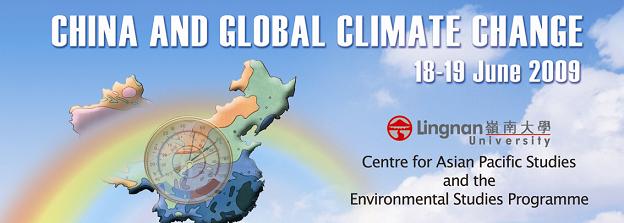
Event Title
Conference on China and Global Climate Change : Reconciling International Fairness and Protection of the Atmospheric Commons
Location
AM308, Lingnan University
Start Date
18-6-2009 2:00 PM
End Date
18-6-2009 3:30 PM
Language
English
Description
China and the United States have the ability to radically shape a successor treaty to the Kyoto Protocol. China’s placement as a non-Annex I nation under the Kyoto Protocol has had significant negative consequences for climate change, and China is now the top emitter of greenhouse gases in the world. The United States has thus far refused to sign the Kyoto Protocol. China will not sign a Kyoto successor treaty unless the United States is on board and vice versa. If either party is uncooperative in negotiating a successor treaty, there will be no effective treaty. The Kyoto Protocol has in large part failed because of the roles China and the United States have played.
This paper will discuss how the interplay between China and the United States will affect mitigation in a Kyoto successor treaty. This paper argues that China and the United States must agree to reduce greenhouse gas emissions to eighty percent below 1990 levels by 2050. First, this paper will discuss basic climate change science, focusing on what the experts say greenhouse gases (including carbon dioxide) and temperature must be stabilized at as well as the mitigation measures necessary to achieve those stabilization goals. Second, this paper will summarize what happened at the Bali and Poznan conferences and how those two meetings set the stage for Copenhagen in 2009. Third, this paper will outline the necessary framework for mitigation in a Kyoto successor treaty. Fourth, this paper will address the challenges of implementing a Kyoto successor treaty in the United States and in China. Lastly, this paper will discuss how the world, and in particular the United States and China, is reacting and could react to mitigating climate change in light of the current economic crisis. With the recent approval of Todd Stern as the United States Special Envoy for Climate Change and the March 2008 elevation of China’s State Environmental Protection Agency into a Cabinet ministry, both nations are now in the position to cooperate and lead the rest of the world in negotiating a successful Kyoto successor treaty.
Document Type
Discussion
Recommended Citation
Dinello, E. (2009). Climbing the Great Wall: How the interplay between China and the United States will affect mitigation in a Kyoto successor treaty. In China and global climate change: Proceedings of the conference held at Lingnan University, Hong Kong, 18-19 June 2009 (pp. 206-221). Centre for Asian Pacific Studies and the Environmental Studies Programme, Lingnan University, Hong Kong.
Included in
Climbing the Great Wall : how the interplay between China and the United States will affect mitigation in a Kyoto successor treaty
AM308, Lingnan University
China and the United States have the ability to radically shape a successor treaty to the Kyoto Protocol. China’s placement as a non-Annex I nation under the Kyoto Protocol has had significant negative consequences for climate change, and China is now the top emitter of greenhouse gases in the world. The United States has thus far refused to sign the Kyoto Protocol. China will not sign a Kyoto successor treaty unless the United States is on board and vice versa. If either party is uncooperative in negotiating a successor treaty, there will be no effective treaty. The Kyoto Protocol has in large part failed because of the roles China and the United States have played.
This paper will discuss how the interplay between China and the United States will affect mitigation in a Kyoto successor treaty. This paper argues that China and the United States must agree to reduce greenhouse gas emissions to eighty percent below 1990 levels by 2050. First, this paper will discuss basic climate change science, focusing on what the experts say greenhouse gases (including carbon dioxide) and temperature must be stabilized at as well as the mitigation measures necessary to achieve those stabilization goals. Second, this paper will summarize what happened at the Bali and Poznan conferences and how those two meetings set the stage for Copenhagen in 2009. Third, this paper will outline the necessary framework for mitigation in a Kyoto successor treaty. Fourth, this paper will address the challenges of implementing a Kyoto successor treaty in the United States and in China. Lastly, this paper will discuss how the world, and in particular the United States and China, is reacting and could react to mitigating climate change in light of the current economic crisis. With the recent approval of Todd Stern as the United States Special Envoy for Climate Change and the March 2008 elevation of China’s State Environmental Protection Agency into a Cabinet ministry, both nations are now in the position to cooperate and lead the rest of the world in negotiating a successful Kyoto successor treaty.

